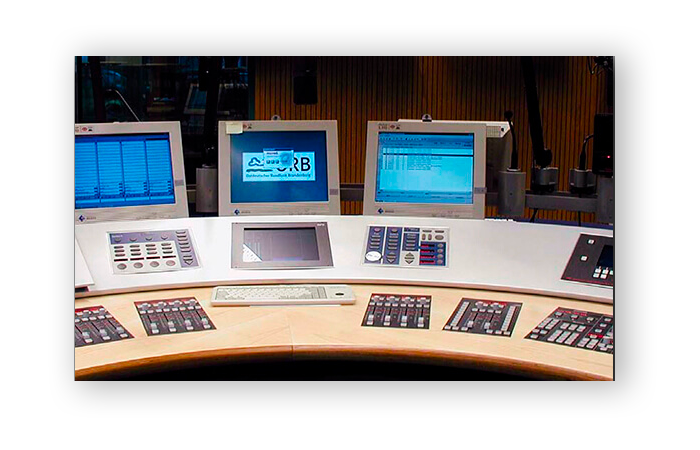LEGACY PRODUCT
GMIX Modular Digital Audio Mixers: Tailoring Control to Your Needs
A Modern Mixer Concept with Versatile Modules for Customizable Control Surfaces

Home > Legacy Products > GMIX
GMIX: Modern Modular Audio Mixers for Tailored Control Precision Control and Adaptability for the Modern Audio Mixing Experience
The GMIX introduces a contemporary modular audio mixer concept, providing intuitive control surfaces to manage a wide array of advanced functions. Its mixer surface comprises individual modules that can be positioned within the console to best match each customer’s operational and ergonomic preferences:
- Fader modules with or without motors
- The central module featuring antenna, aux, intercom, and monitoring controls
- The main module equipped with a 6.5” TFT screen for configuring mixer settings and filter parameters
- The information module boasting a 10.5″ screen for displaying levels, timers, ON AIR status, and more.
Furthermore, an external display can replace the information module to show output levels and other customizable parameters as per the customer’s preferences. Additional modules, such as larger keyboards for audio monitoring and telephone modules for remote telephone screener system control, are also available.
The layout of the control surfaces and mixer functions can be customized to meet individual customer requirements, providing flexibility in design.
Additionally, the console remotely manages the switching circuitry and DSPs within the matrix.
Key Features of Master Modules:
MASTERS
- Selection keys for compressor, on-air management, timer, and WAV recorder
- LED indicators for on-air and overload
- 8-character display for function status
AUXES
- Selection keys for compressor and WAV recording
- dB meter
- Overload LED
- 8-character display for function status
- Knob for gain adjustment
- Talk key
- Output enable key
MONITORING
- Selection keys for input or output lines
- 8-character display for function status
- Knobs for gain control (main monitor, PFL monitor, phones monitor)
- 8 programmable keys for input or output line functions
- 3 additional function keys (e.g., phase, mono, PFL off, split PFL, etc.)
INTERCOM
- Selection keys for output lines
- 8-character display for function status
- Knob for gain adjustment
- 8 programmable keys for output line functions
- Talk key
- Intercom group
- Communications group
- Answer key
- Red light indicator
GPIO
- Four user-programmable 8-character displays
- Eight user-programmable keys; all displays and keys can be controlled via GPIO functions
Key Features of Fader Modules:
- Rotary knobs with push-button functions for gain, balance, width, return gain, mic level, line input gain, aux level, and more
- High-quality faders, typically with motorization
- 8-character display for object titles or names
- LEDs indicating compressor level (input or output)
- LED level meters (Input or Output)
- LEDs for overload, active processing, and parameter adjustments
- 5 programmable function keys (e.g., ON, PFL, talk, external, n-m, record…)
Additional modules available include the Info Module and Telephone Module.
GMIX - Elevate Your Audio Mixing Experience
- Modular Versatility: GMIX offers customizable control surfaces with various modules, including fader, central, main, and information modules, allowing tailored configurations
- Advanced Master Modules: Master modules provide essential functions, from compressor control to audio monitoring, and feature user-friendly displays and keys
- High-Quality Fader Modules: Fader modules feature rotary knobs, motorized faders, and LED indicators for precise audio control and signal management
GMIX
Download the Technical Datasheet for GMIX
Explore all the specifications and advanced features of the professional GMIX in this technical datasheet.
